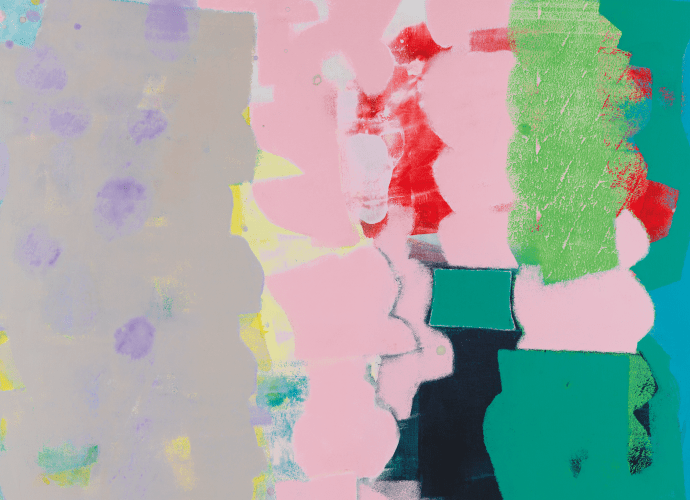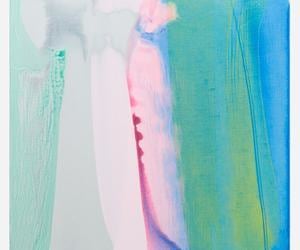
Yunhee Min | CURATOR
Interview with Dan Golden
May 2016

By Dan Golden
Yunhee Min is an artist based in Los Angeles. She is interested in painting as foremost a studio practice, where hands-on engagement with the material and the activity of making take priority. Although she has explored the cultural, social, and historical dimensions of signification of color in her previous work, she is currently interested in the potentialities of color as pure sensation.
You have an exhibition opening at Ameringer McEnery Yohe on May 26th. Please tell us a bit about the new body of work.
The exhibition at Ameringer McEnery Yohe will present my recent and continuing body of paintings that explore color, gesture and abstraction. This is my first solo show in New York featuring paintings. In this show, I try to think about and emphasize the activity of looking that takes time. And in a sense, the paintings are asking for viewer’s active participation by looking closely. I even had benches made for the show! (designed by Peter Tolkin) While there is an initial gestalt of the painting as a whole, the distinctive spaces in these paintings, implied through color and movement unfold with time. In a word, it is meant to be a s-l-o-w experience. The world is busy enough.
There appears to be a clear thread in your paintings connecting back to artists like Morris Louis and Color Field painting in general. Would you consider that earlier work to be a primary reference, or is that simply a surface reading?
Yes, the Color Field painting history is very important and influential to me. Morris Louis, yes, but also Frankenthaler and Olitzki as well as paintings by John McLaughlin whose careful and elegant compositions unclutter your mind and by Marcia Hafif's paintings. The surface of her paintings are incredibly sensitive and put you in a different time entirely. In Louis’ work specifically, there is a sense of both material presence and immaterial affect through the urgency of color, which to this day feels fresh and generative to me. My paintings would not fit neatly into Louis’ syntax of marks but the reference is a compliment and I am flattered by it. I learned a lot from his early rigorous experimentations of compositions and applications before he really arrived at his own particular vocabulary of marks. His first round of veil paintings from 1954 are fantastic.
Can you give us some insight into your painting process?
My painting process involves various stages, some seemingly more pragmatic than others but all stages are vital in the end.
I begin with making my colors/paint ready. This means adjusting the viscosity of paint as well as mixing colors. There are plenty of colors straight out of the tube in my paintings but they still need to be mixed with water and mediums to extend the consistency. I like it best when it is somewhere between whole milk and cream consistency. I spend days just getting the colors ready. And they are often my favorite studio days before the actual application begins on the surface.
Often though not direct, I take my color studies as starting points. The color studies take varied forms from vertical bands to biomorphic pours on paper. They help me to select a group of colors to begin the painting. Once the application of paint begins the process of painting is very durational - kind of like cinema where time can be stretched beyond the actual time. So in a sense I am walking into the process without knowing how it might play out. It is an experience that takes time of looking and responding. And you hope to walk through unexpected places along the way, which can feel both exciting and unnerving.
Unique to the process in recent paintings is the use of squeegees. I have been using them as my primary instrument of application for several years now and still find them to be interesting as tools. The marks made with them give a sense of distance yet remain close to my body simultaneously. In the end, the tools are invisible to the degree that we are not thinking about it when viewing the work.
We've read that you are interested in exploring the "potentialities of color as pure sensation". Can you talk more about the importance of color for you and your work?
Color is primary material in my work. As my friend Daniel Mendel-Black says in talking about painting, color does most of the hard work. Color can operate in many ways and produce meanings in different kinds of contexts: cultural, historical, social, linguistic as well as material.
In painting color can function in special ways. Color relationships can privilege perceptual experience of sensation beyond the associative and significatory readings. This does not happen in a vacuum of course but painting is a unique aesthetic situation where color can exist as color, as visible phenomenon of light and surface. I am excited by what can be felt and experienced there.
You have a Bachelor of Fine arts degree from Art Center in Pasadena, and a Masters in Design Studies from Harvard University. What drew you to that (design) program, and how do you see your work in that area feeding back into your art practice?
I didn’t take a standard artist path of education. In fact, I don’t even have a MFA! I had no desire to go onto grad school after completing undergraduate degree. I was yearning to experience something different entirely. So, I moved to Germany and attended Kunstakademie Düsseldorf for a year. It was a memorable character-building experience, being alone in a foreign country and at the same time you learned how to "style," so to speak. The artist/professor roster was pretty stellar and everyone seemed to have attitude. It was a lot of fun and I met two of my closest friends at the Akademie, Patrick Meagher and Miles Coolidge. We actually made a collaborative exhibition about this at Night Gallery in 2011, WP9.
I had been showing work and teaching for some time when I did decide to return to graduate school later on. I felt that I had a particular goal - to look closely and to think about the role of architecture in my site-work that had become more and more prominent in my practice. It was a very intense time. It was a break from studio practice and I read a lot.
In addition to your gallery exhibitions, you've done a number of really interesting large scale installation projects. Is the underlying intent of those (site-specific) works the same or different than your more formal paintings?
Yes, in my site-projects, I address the physical, actual built spaces whereas in paintings, I am dealing with implied space in a static object - two very different conditions and limits. I think about how a space/architecture can be experienced through actual physical movements in site-projects. Every site is comes with unique specificities and I love the opportunity to work with new materials and ways of making that is not possible in my studio.
Can you talk about the importance material selection plays in your work? For example, we read that in a previous project you worked with unclaimed house-paints.
Yes, that was some time ago but true. In the mid-late 90’s I worked exclusively with mistints, which are rejected custom-mixed housepaint. I would buy them from Home Depot and other paint stores at discounted price and make paintings using these “failed” colors. I was interested in their status of not quite being in fashion or meeting the desire. The choice of the material in this work was conceptual and structural.
In general, the choice of materials is motivated by both a certain sense of métier as well as a kind of efficiency in the desired affect in the project.
What are you working on right now/what's next?
I am currently working on a collaborative site-project, “Red Carpet in C,” with Peter Tolkin who is an architect, for the Culver Center in Riverside, CA to be realized in 2017.
http://curator.site/interviews/2016/5/24/yunhee-min